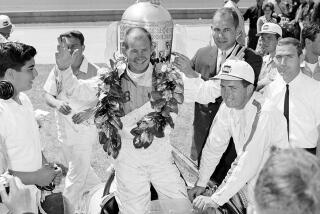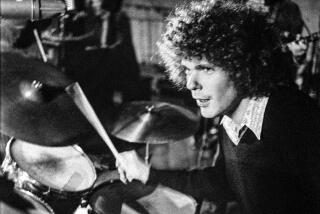The Lessons of a Checkered Past
- Share via
When Jeff Gordon was 5 and 6 he won so many races in karts and quarter-midgets around his hometown in Vallejo that he lost track of the number.
By the time he was 14 he had run out of places to race, not old enough to drive sprint cars in California, so the family moved to a more race-friendly environment in Pittsboro, Ind.
For the record:
12:00 a.m. March 2, 2005 For The Record
Los Angeles Times Wednesday March 02, 2005 Home Edition Main News Part A Page 2 National Desk 0 inches; 30 words Type of Material: Correction
NASCAR driver -- An article in Sunday’s Sports section said Junior Johnson provided a push to Jeff Gordon near the end of the Daytona 500. Jimmie Johnson provided the push.
The winning continued, Gordon setting records in U.S. Auto Club open-wheel racing as the youngest to earn a professional license at 16, the youngest to win a USAC national title at 19. The wins just kept coming until NASCAR called.
The experience of seeing the checkered flag apparently set the tempo for his career.
“I learned quite a while ago that it’s not racing I love, it’s winning,” he says matter-of-factly.
Now 33, Gordon’s winning record would indicate that he is on a path to easily surpass the two icons of NASCAR Cup racing, Richard Petty and Dale Earnhardt, each of whom has seven championships.
Gordon has four and would have had five had the rules not been changed for the 2004 season. He was only 30 when he won his fourth. Petty was 35 and Earnhardt 41.
Earnhardt was “the Intimidator,” but despite Gordon’s choir boy looks and polite persona, he can be as intimidating as anyone. Just ask Tony Stewart and Dale Earnhardt Jr., who saw the No. 24 Dupont Chevrolet roar past them in the final laps of last Sunday’s Daytona 500.
The final laps looked like chaos, but there was Gordon powering around Stewart on the high side of the 31-degree banking where no one had dared challenge, and then with a push from teammate Junior Johnson he swept past Little E moments later and was in front to stay.
“Those are the moments that you live for,” Gordon said. “Those are the moments we get paid the big bucks for. You know, you live to be in that position, to have chaos happening all around you, for your car to lead the pack and to get out there.
“And when you get in that position you better make damn sure that nobody passes you. I enjoy being in that position. You know, I want to see that checkered flag really bad.”
It wasn’t the first time he had showcased his daring at Daytona.
In 1997 he drove deep down on the apron to pass Rusty Wallace and the lapped car of Ricky Rudd two laps from the end to beat Earnhardt to the finish line. At 26, he became the youngest driver to win the Daytona 500.
When he won last Sunday, it was his 70th Cup win. Earnhardt was 44 when he reached that landmark, 11 years older than the youngster he once derisively called “Wonder Boy.”
Today, in the Auto Club 500, Gordon will try to win for the fourth time at California Speedway. No one else has won more than once since the Fontana track opened in 1997. Gordon won that year, again in 1999 and collected No. 3 last year.
Fontana poses a different problem than in past years as it follows Daytona by a week with an entirely different set of regulations.
“We’ve been in Daytona for 10 days doing nothing but focusing on restrictor-plate racing and we get to Fontana and it’s the exact opposite,” Gordon said. “It’s going to take horsepower, downforce, balance, handling, and a total team effort with the pit crew and everything.
“So to me, this weekend is a true tale of who is going to be strong throughout the year. I’m hoping we can use this as momentum and keep up the good work.”
The momentum slowed a bit Saturday as Gordon qualified a disappointing 28th at 184.677 mph, nearly four miles slower than Kyle Busch, the rookie pole-sitter.
Busch, only 19, can thank Gordon for getting a chance to drive a Nextel Cup car at such a young age. Before Gordon joined the major league circuit at 21, most rookies were in or nearing their 30s. Experience and “paying your dues” were considered more important than youthful speed.
“It does seem like it started a bit of a trend because it showed that car owners could take a chance on a younger guy and the sponsors are willing to take that risk a lot more today,” Gordon said. “And they have learned that it could pay off, especially in the future of their team.
“When I came along, I was considered a very young driver. There had been others, like Ricky Rudd, but not many got a look. It just so happened in the past it had only happened with older drivers. Guys like myself and Tony Stewart and Kurt Busch played a role in that.”
Earlier Saturday, Gordon was inducted into the speedway’s Walk of Fame for the third time, putting his footprint and signature into concrete.
“I definitely want the right foot to be heavier than the left,” he said.
Last year he was presented with a surfboard after his win.
“I’ve looked at it sitting in the corner many times and said, ‘Man, I’d sure like to ride this thing.’ ”
He received a snowboard Saturday for last year’s win.
“This is awesome,” he said. “I did some snowboarding over the break in Colorado. All the rain you guys have been getting, there’s a lot of snow up in the mountains. I may even get to try this thing out tonight.”
As always when Gordon is introduced, before races or in the winner’s circle, there is a smattering of boos. It is something that has followed him ever since he came up as a fuzzy cheeked youngster and knocked off Earnhardt and the other old-timers of NASCAR.
“I tried to figure out why a long time ago and kind of stopped somewhere along the way when I realized that my focus is to be a part of a team who tries to win races and championships and be myself and be the best person I can,” Gordon said. “I’m very grateful for the people who follow me. I have a great fan base.
“But those who don’t [like me] are entitled to their opinion. They can boo or do whatever they want. I’ve just learned not to let it bother me. If they’re putting effort into making signs that say ‘Anybody but the 24’ then obviously I’ve gotten their attention and that’s a good thing.”
One theme consistent with all of Gordon’s comments is his insistence on giving credit to his crew chief Robbie Loomis, his crew, his support system back in the garage and his car owner, Rick Hendrick.
“It’s unbelievable to know that since I met [Hendrick] in May of 1992, it’s been one incredible ride,” he said. “And who would have ever thought that we would have racked up the things that we have?
“You know, I know how hard these guys, Robbie and the engine guys, all of them, how hard they work. Sometimes the results pay off, sometimes we fall a little short, but it’s never for their lack of trying.”
*
(BEGIN TEXT OF INFOBOX)
Chart Toppers
Jeff Gordon is among the top five in victories and pole positions in the NASCAR modern era (since 1972):
*--* VICTORIES 1. Darrell Waltrip 84 2. Dale Earnhardt 76 3. Jeff Gordon 70 4. Cale Yarborough 69 5. Richard Petty 60 6. Bobby Allison 55 6. Rusty Wallace 55 8. David Pearson 45 9. Bill Elliott 44 10. Mark Martin 34 POLES 1. Darrell Waltrip 59 2. David Pearson 56 3. Bill Elliott 55 4. Cale Yarborough 51 5. Jeff Gordon 46 6. Mark Martin 41 7. Geoff Bodine 37 8. Rusty Wallace 36 9. Bobby Allison 35 10. Buddy Baker 30
*--*
More to Read
Go beyond the scoreboard
Get the latest on L.A.'s teams in the daily Sports Report newsletter.
You may occasionally receive promotional content from the Los Angeles Times.










